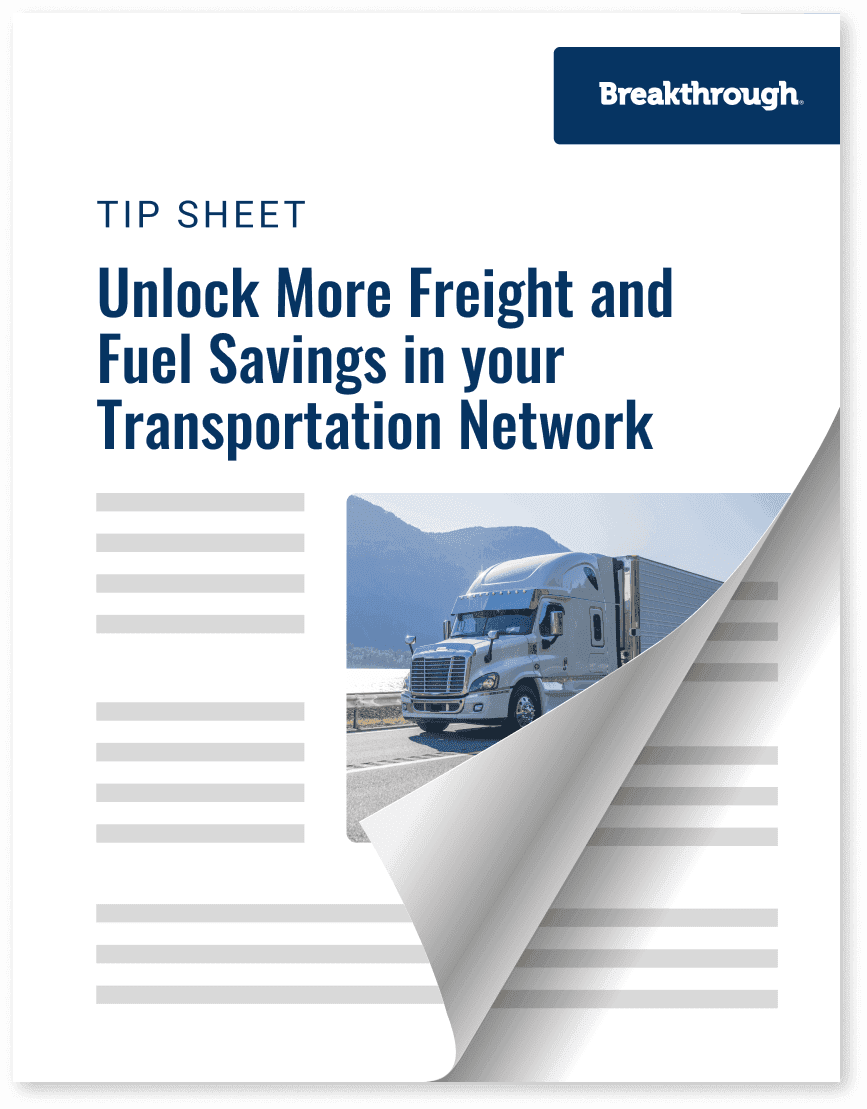Unlock More Freight & Fuel Savings in your Transportation Network

Trending
Top Posts
Market Events
Geopolitical Risks: Navigating Volatility in Energy Markets
4 min read
October 18, 2024
Sustainability and Tech
What Is Logistics Transportation Management? 4 Advantages for Success
4 min read
October 15, 2024
Sustainability and Tech
AI in Logistics: How Shippers Can Uncover Freight Efficiencies
4 min read
October 14, 2024

7 min read
July 30, 2018

Share:
Much like any free market, freight rates and carrier capacity are under the influence of fluctuating market dynamics. In cyclical fashion, rates go up as capacity tightens, and as the market adapts by flooding with truck and driver availability, rates inevitably relax. What is important to remember through this changing process is that underlying every policy change, technological innovation, driver shortage, and economic stressor are economic market fundamentals.
Today’s market reflects tight capacity conditions. According to JOC.com, some of the largest carriers in the U.S. truckload sector have implemented rate increases in the double digits.
CNN Money noted that 148 companies in the S&P 500 mentioned “freight,” “shipping,” or “trucking” during recent earnings calls. That’s twice as many as a year ago. Without question, shippers are extremely cognizant of today’s competitive freight market and have their hands full managing the costs and efficiencies of supply chains.
In 2018, the freight market is under the influence of numerous key drivers, including economic growth, changing regulations, and supply and demand dynamics that put us in an extended season of tight capacity. So, what are these drivers?
In 2017, we saw more pronounced economic growth than the previous year. According to the U.S. Department of Commerce’s Bureau of Economic Analysis, Domestic GDP increased by 2.3 percent in 2017—almost double the growth rate seen in 2016. This recent increase in GDP is primarily due to increases in personal consumption expenditures (PCE), more colloquially referred to as consumer spending. As the average person increases individual consumption of material goods in times of economic success, shipping volumes increase as they adapt to meet demand in the marketplace. Combined with the growing need to satisfy on-demand shipping needs, the activity seen in the freight space contributes to tight capacity as the demand for the movement of goods surpasses the supply of available trucks.
Freight Waves calls it a “perfect storm.” The continued rise of e-commerce combined with an uptick in U.S. manufacturing and construction is further tightening trucking capacity.
U.S. construction is expected to grow around five percent in 2018, while certain growth expectations for U.S. manufacturing are being revised upwards from 1.5 percent to 2.8 percent from 2018 to 2021. More construction and manufacturing obviously mean more demand to ship raw materials.
On the B2C side, brands and retailers continue moving toward e-commerce to meet consumers’ propensity for online shopping, having even the most basic items delivered to their doorsteps. Consumers are driving the “on-demand economy” and expect shorter order cycle times.
All of these can be tough expectations to meet with tight capacity and regulations that slow down the supply chain.
At the root of concerns about tight capacity lies a fundamental economic phenomenon: supply and demand. There simply aren’t enough trucks and drivers to handle the demands of U.S. shippers.
Unemployment is the lowest it’s been in nearly two decades. Because of the tight labor market, wages for truck drivers are increasing to attract and retain prospective and current truckers.
It’s estimated that the long-haul trucking industry will be 63,000 drivers short by the end of 2018. The crisis has reached the point that Congress is even considering a move to lower the interstate truck driving age to 18. This would open the door to younger drivers, which provides huge opportunity for young workers in a time when many career drivers are retiring. Recruitment is, of course, still a barrier to overcome in order to fulfill the necessary positions in the marketplace.
While these factors are the primary drivers of the current freight environment, other changes are at play as well—however to a lesser extent. For example, the Electronic Logging Device (ELD) mandate—effective as of December 18, 2017 creates a new operational and financial obligation for carriers and private fleets alike. Electronic logging devices enforce more accurate reporting of driver hours; therefore, drivers may be limited in the number of loads they are able to pick up to stay within legal hours-of-service (HOS) limits. This ultimately shortens the distance drivers can travel in a day, tightening trucking capacity even further and putting more pressure on shippers and carriers trying to get goods to market.
Similarly, changing emissions standards play into this tight market in several ways. When emissions standards are in effect, older truck technology may need to be taken off the road for being non-compliant. Carriers must either invest in new, cleaner technology, adapting old vehicles to keep their fleets operational, or they need to abandon old vehicles in search of new fuel-efficient models. If none of these options are possible, carriers pay large fines. Fuel portfolios will begin to diversify, ultimately having an effect on the operations and costs associated with working with certain carrier partners as they adapt to meet these new demands.

Breakthrough’s growing influence within the transportation marketplace strengthens the value of both the information and collaboration opportunities that are possible with our Fuel Recovery and Supply Chain solutions. The chart above illustrates the density of shipment volume among Breakthrough clients in 2017—all of which now fuels our Supply Chain capabilities.
What is clear is that capacity is tight, however all the challenges associated with this type of market do not need to force your transportation team to be at the mercy of the market. By unbundling your transportation costs—specifically regarding fuel and freight—you can gain better control over reimbursements, ultimately reducing costs associated with fuel.
Transitioning your fuel reimbursement strategy to a market-based approach like Fuel Recovery makes fuel a pass-through expense. In doing this, fuel becomes a separate bucket to be managed independent from linehaul. Backed by actual data taken in real time and at the lane level, fuel prices are calculated accurately. When freight rate increases are requested, you can ensure that your fuel cost is not increasing by association and clearly decide if and how you want to adjust freight rates based on the value your carrier partners are providing. These accurate prices for each of your individual shipments are then transmitted to you, your carriers, and your TMS system, eliminating the topic of fuel from your rate discussions completely, so you can focus on service requirements.
Fuel spend can make up as much as 30 percent of your overall transportation budget. That is a large portion of the budget that is going completely unmanaged if you are not taking steps to actively manage that spend and leverage the best data and technology available. Within the complexity of today’s freight market, fuel management is made easy and accurate. Having a team of industry experts calculating reimbursements based on market data relieves it as a responsibility to manage as a transportation team, preventing it from sliding through under the radar—which would ultimately accrue excess cost through over-reimbursement. Conversely, failing to fairly and accurately manage the cost of fuel that moves goods to market forces carriers to build in a fuel risk premium for under-reimbursement in states like California, which have tax implications not accurately represented in a traditional fuel surcharge approach to reimbursement.
The right fuel management strategy should alleviate some of the stress associated with tight capacity and fuel market fluctuations by eliminating economic distortion from traditional fuel surcharges. It should create transparent data at the individual lane level, and establish fair relationships surrounding both fuel and freight rates between shippers and carriers translating into a better understanding of your network and more capacity options.
Take control of your transportation costs and let the data do the work. For more information about Fuel Recovery and other Breakthrough services, contact us!

4 min read
October 18, 2024
Explore how geopolitical tensions and hurricane season are driving energy market volatility in 2024, significantly impacting oil prices and routing guides.
Read more
4 min read
October 15, 2024
Discover the benefits of using a logistics transportation management provider to streamline operations, enhance visibility, and meet sustainability targets.
Read more
4 min read
October 14, 2024
Explore how AI in logistics is advancing the supply chain through route optimization, market forecasts, and benchmarking, providing shippers innovative solutions.
Read more